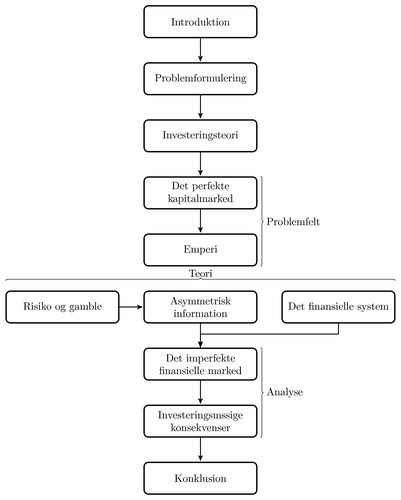The structure of an assignment illustrated using a flow chart. Labels are in Danish.

Edit and compile if you like:
% Author: Rasmus Pank Roulund
\documentclass{minimal}
\usepackage{tikz}
\usetikzlibrary{calc,trees,positioning,arrows,chains,shapes.geometric,%
decorations.pathreplacing,decorations.pathmorphing,shapes,%
matrix,shapes.symbols}
\tikzset{
>=stealth',
punktchain/.style={
rectangle,
rounded corners,
% fill=black!10,
draw=black, very thick,
text width=10em,
minimum height=3em,
text centered,
on chain},
line/.style={draw, thick, <-},
element/.style={
tape,
top color=white,
bottom color=blue!50!black!60!,
minimum width=8em,
draw=blue!40!black!90, very thick,
text width=10em,
minimum height=3.5em,
text centered,
on chain},
every join/.style={->, thick,shorten >=1pt},
decoration={brace},
tuborg/.style={decorate},
tubnode/.style={midway, right=2pt},
}
\begin{document}
\begin{tikzpicture}
[node distance=.8cm,
start chain=going below,]
\node[punktchain, join] (intro) {Introduktion};
\node[punktchain, join] (probf) {Problemformulering};
\node[punktchain, join] (investeringer) {Investeringsteori};
\node[punktchain, join] (perfekt) {Det perfekte kapitalmarked};
\node[punktchain, join, ] (emperi) {Emperi};
\node (asym) [punktchain ] {Asymmetrisk information};
\begin{scope}[start branch=venstre,
%We need to redefine the join-style to have the -> turn out right
every join/.style={->, thick, shorten <=1pt}, ]
\node[punktchain, on chain=going left, join=by {<-}]
(risiko) {Risiko og gamble};
\end{scope}
\begin{scope}[start branch=hoejre,]
\node (finans) [punktchain, on chain=going right] {Det finansielle system};
\end{scope}
\node[punktchain, join,] (disk) {Det imperfekte finansielle marked};
\node[punktchain, join,] (makro) {Investeringsmæssige konsekvenser};
\node[punktchain, join] (konk) {Konklusion};
% Now that we have finished the main figure let us add some "after-drawings"
%% First, let us connect (finans) with (disk). We want it to have
%% square corners.
\draw[|-,-|,->, thick,] (finans.south) |-+(0,-1em)-| (disk.north);
% Now, let us add some braches.
%% No. 1
\draw[tuborg] let
\p1=(risiko.west), \p2=(finans.east) in
($(\x1,\y1+2.5em)$) -- ($(\x2,\y2+2.5em)$) node[above, midway] {Teori};
%% No. 2
\draw[tuborg, decoration={brace}] let \p1=(disk.north), \p2=(makro.south) in
($(2, \y1)$) -- ($(2, \y2)$) node[tubnode] {Analyse};
%% No. 3
\draw[tuborg, decoration={brace}] let \p1=(perfekt.north), \p2=(emperi.south) in
($(2, \y1)$) -- ($(2, \y2)$) node[tubnode] {Problemfelt};
\end{tikzpicture}
\end{document}
%%% Local Variables:
%%% mode: latex
%%% TeX-master: t
%%% End:
Click to download: assignment-structure.tex • assignment-structure.pdf
Open in Overleaf: assignment-structure.tex


